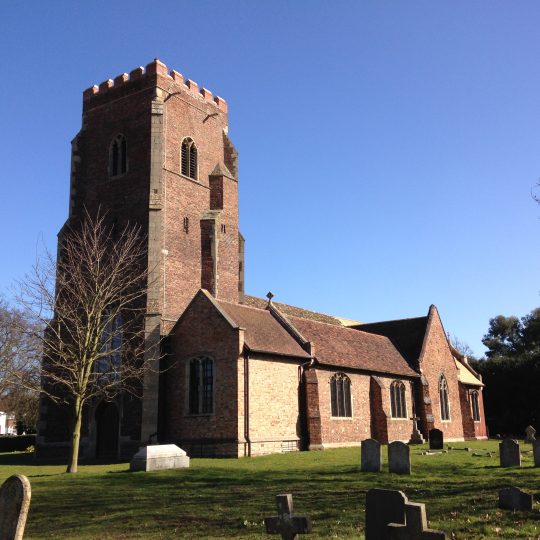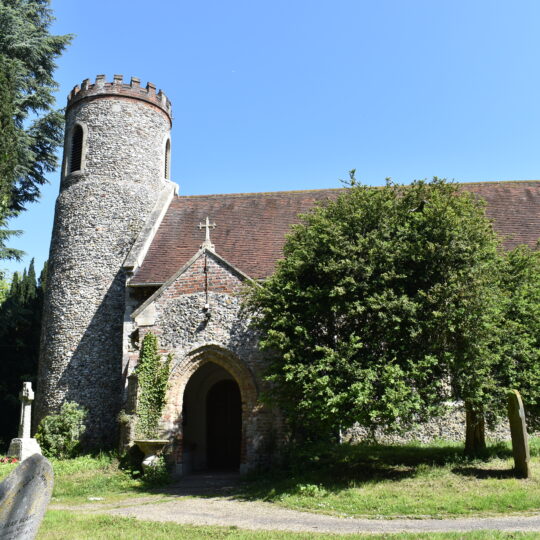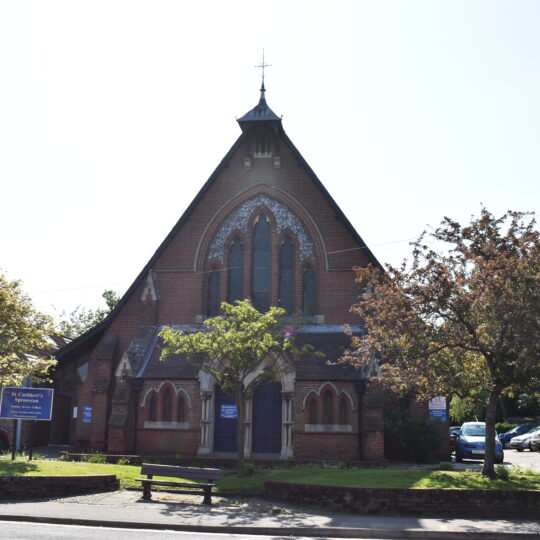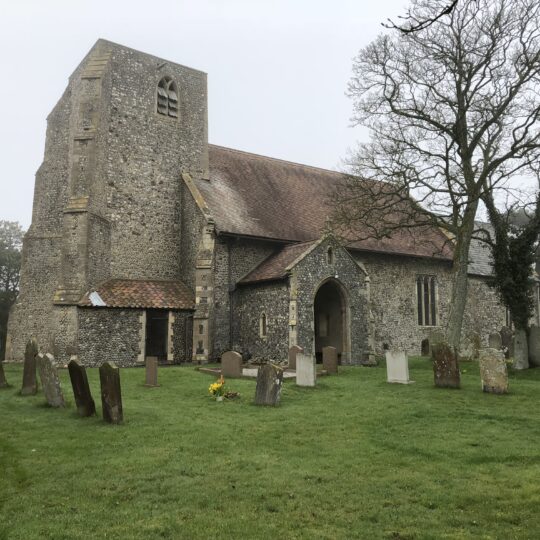The Unusual Dedications of Norfolk Churches
For example, churches were often founded on the site of a saint's activity, e.g. St Beza's Church in St Bees, Cumbria. Other churches were dedicated to their founder such as St Etheldreda at Ely Cathedral. A collection of relics of foreign saints has also inspired dedications, such as St Firmin's Church in Buckinghamshire. Geographical areas became associated with specific saints, e.g. the West Midlands and St Chad. As the patron saint of sailors and fishermen, you will find a church of St Nicholas in most English coastal towns. Churches of St Giles are often located near the medieval gates of fortified towns as he was the patron saint of beggars and disabled people, e.g. the Church of St Giles-without-Cripplegate in the City of London.
The consecration of a church involved an elaborate ceremony and subsequent annual celebrations with a public holiday and feast. After the Reformation, the tradition of church dedications began to fade away apart from a practical usage to differentiate churches that were positioned close together. By the 18th century many churches had forgotten their name entirely. The increase in church building during the Victorian era saw a renewed commitment to dedications and gave rise to names such as 'St Michael and All Angels' and 'All Hallows'.
Enthusiastic antiquarians and rectors digging back into parish records and coming across altar dedications are responsible for many of the later names of medieval churches. Norfolk has its fair share of unusual church dedications.
St Withburga
St Withburga (d. 743) was the youngest daughter of Anna, King of the East Angles. After the death of her father Withburga built a convent at East Dereham. According to tradition, she only had dry bread to feed her workmen and appealed to the Virgin Mary for assistance who directed her maids to a fountain. Next to this fountain were standing two does who provided milk and work subsequently prospered. A local official hunted the does and was punished when he was thrown off his horse and his neck broken. Withburga was buried at East Dereham Abbey and her body was found well preserved fifty-five years later. This became a site of pilgrimage and her holy well remains in the churchyard to this day. In 974 the Abbot of Ely carried her body off for burial in Ely alongside her sisters. Their remains were moved nearer the main altar in 1106 and the bodies were displayed before senior clergy who witnessed the miraculous preservation. These tombs did not survive the Reformation and no trace of them now exists. The church in Holkham is the only one dedicated to St Withburga.
St Clement
St Clement (d. 1st century) was a principle theologian amongst the Church Fathers, supposed third successor of St Peter the Apostle and the fourth pope. St Irenaeus noted that he was a contemporary of the apostles and witnessed their teaching. According to tradition, Clement converted over four hundred high ranking people and was subsequently banished from Rome to the Crimea by Emperor Trajan. There he miraculously quenched the thirst of two thousand Christians and inspired the building of seventy five churches. Trajan then ordered Clement to be thrown into the sea attached to an anchor, which became his attribute in depictions. The tide receded revealing a divinely-built shrine containing his bones.
Holy Innocents
Holy Innocents refers to the massacre of children by King Herod in Bethlehem who was attempting to kill the infant Jesus (Matthew 2:16-18). These children are regarded as the first martyrs. The feast day falls on December 28th in western churches and was a solemn affair characterised by fasting. Children in medieval England were whipped in bed in the morning and this practice continued into the 17th century. In Catholic countries today, the feast in honoured by omitting the Gloria and the Alleluia from the mass but is otherwise a day of merrymaking for children.
St Walstan
St Walstan was born in Bawburgh around 960 AD, the son of St Blide who is buried at St Mary’s Church in Martham near Great Yarmouth. At the age of twelve St Walstan gave up all of his possessions and left home to work as a farm labourer. He became renowned for his piety and generosity, and gave away his wages. According to tradition, sick animals were brought to him to be cured. Towards the end of his life he had many visions, including one which foretold his death in three days. He asked his fellow workers to place his dead body on a cart and to allow the oxen to wander at will. Wherever they stopped he would be buried. St Walstan died on 30th May 1016, and his wishes were honoured. The oxen stopped first at Costessey where a spring appeared and finally came to a halt in the valley below Bawburgh Church where another spring gushed forth, becoming known as St Walstan’s Well. He was buried in the presence of the Bishop and several clergy.
St Faith
St Faith (d. 3rd-4th century) was a young woman who lived in Aquitaine, France at the time of Roman Emperor Maximian. When she refused to make a sacrifice to pagan gods she was tortured on a red-hot brazier. According to tradition, it miraculously began to rain which extinguished the fire and necessitated St Faith’s subsequent beheading. A basilica dedicated to her was built in the 5th century on the site of the martyrdom. However, it was the abbatial church of St Foy in Conques, situated on the pilgrimage route to Compostela, that became the centre of her cult. In 1105, a priory was built in Horsham St Faith, Norfolk in her honour. The parish church, however, is dedicated to St Mary and St Andrew.
St Maurice
St Maurice (d. 287) was the leader of the Roman Theban Legion composed of Christians from Egypt. According to tradition, when the legion refused to fight against fellow Christians in Gaul, Maximian (later Roman emperor) had the entire group executed. The site of this killing in Switzerland became known as Saint Maurice-en-Valais and an abbey was founded. St Maurice is usually shown in full armour and became the patron saint of soldiers, armies, swordsmiths, Holy Roman Emperors and the Vatican’s Swiss Guard. Pope Pius XII declared Saint Maurice to be patron saint of the Italian Alpini Mountain Infantry Corps in 1941. His cult flourished beyond Switzerland along the Rhine and in northern Italy. St Maurice is predominantly depicted as a black man in Germany but elsewhere he is shown as a white man.
St Gervase and St Protase
According to tradition, St Gervase and St Protase (d. 2nd century) were the twin sons of the martyrs St Vitalis and St Valeria. Little is known about their life and martyrdom. St Ambrose was shown the location of the skeletons of St Gervase and St Protase in a dream and had them brought to the Basilica Sant’Ambrogio in Milan where they remain on display in the crypt to this day. The cult of the twin saints spread throughout Italy, Germany and France. They are the patron saints of Milan, haymakers and are invoked for the discovery of thieves.
St Gervaise and St Protase’s, Little Plumstead
St Martin of Tours
St Martin of Tours (d. 397) was the third bishop of Tours and is the patron saint of France. According to tradition, Martin cut his cloak in half to share it with a beggar. He dreamt that Jesus was wearing it and woke to find it miraculously restored. He founded several monasteries in France and was one of the first non-martyrs to be widely venerated as a saint.
St Martin at Tours, Houghton-next-Harpley
St Cuthbert
St Cuthbert (d. 687) was the bishop of Lindisfarne Abbey and is one of the most highly venerated English saints. Cuthbert was originally a shepherd before entering the monastery of Melrose in Scotland. According to tradition he aided plague victims and performed miracles. At Lindisfarne, St Cuthbert withdrew into a life of prayer and solitude, dying naturally in 687, and a small chapel remains at the site of his final hermitage. His body was taken to Durham Cathedral to protect it from Viking desecration and his shrine became a popular pilgrimage destination. The monks of Durham opened the coffin and, it is said, found St Cuthbert’s body miraculously preserved. The coffin was again opened in 1827 and the grave goods are now on display in the cathedral treasury.
St John the Baptist’s Head
St John the Baptist (d. c. 30) was a prophet who preached about God’s impending judgement and baptized those who repented of their sins. Jesus received baptism from John, during which the heavens opened, the Holy Spirit in the form of a dove descended, and God spoke, saying, “This is my beloved Son, in whom I am well pleased.” John’s popularity alarmed Herod who had him imprisoned. Herod granted a wish to his daughter and she asked for John’s head, and so John was martyred. Only two other churches in England share this unusual dedication. The feast day of the Beheading of St John the Baptist falls on 29th August and it is possible that this name was shortened to the less gruesome St John the Baptist’s Head. Amiens Cathedral claims to house the relic of his head.
St Fabian and St Sebastian
St Fabian (d. 250) was the twentieth pope, and is known for the division of the Church into seven diaconates to better serve the faithful. He also oversaw the preservation of the catacombs where the early Christians were buried. Emperor Decius demanded that Christians renounce their faith and worship pagan gods but Pope Fabian refused and was beheaded. He was initially interred in the catacomb of Callixtus before being laid to rest in the Basilica of St Sebastian Outside the Walls in Rome.
St Sebastian (d. 287) was a leader in the Praetorian Guard, the elite unit of the Imperial Roman Army which provided protection to the Roman Emperors. Sebastian hid his Christian faith but was eventually found out and when he would not recant Emperor Diocletian ordered his execution. According to tradition, Sebastian was shot full of arrows but miraculously survived and rebuked Diocletian for his wickedness. The Emperor had him beaten to death. His remains are also housed in the Basilica of St Sebastian Outside the Walls. St Sebastian has long been invoked to provide protection from plague. The feast day of both saints falls on 20th January.
St Agnes
St Agnes (d. 304) was a member of the Roman nobility. According to tradition, she rebuffed suitors and remained devoted to religious purity. The scorned men revealed her Christian faith to the authorities and she was marked for execution. She was bound to a stake but the wood would not catch fire and so she was beheaded. The daughter of Emperor Constantine I is said to have been cured of leprosy after praying at St Agnes’ shrine. Her skull is on display in the church of Sant’Agnese in Agone in Rome. St Agnes is the patron saint of girls and is often pictured with long hair, a lamb and a sword.


















